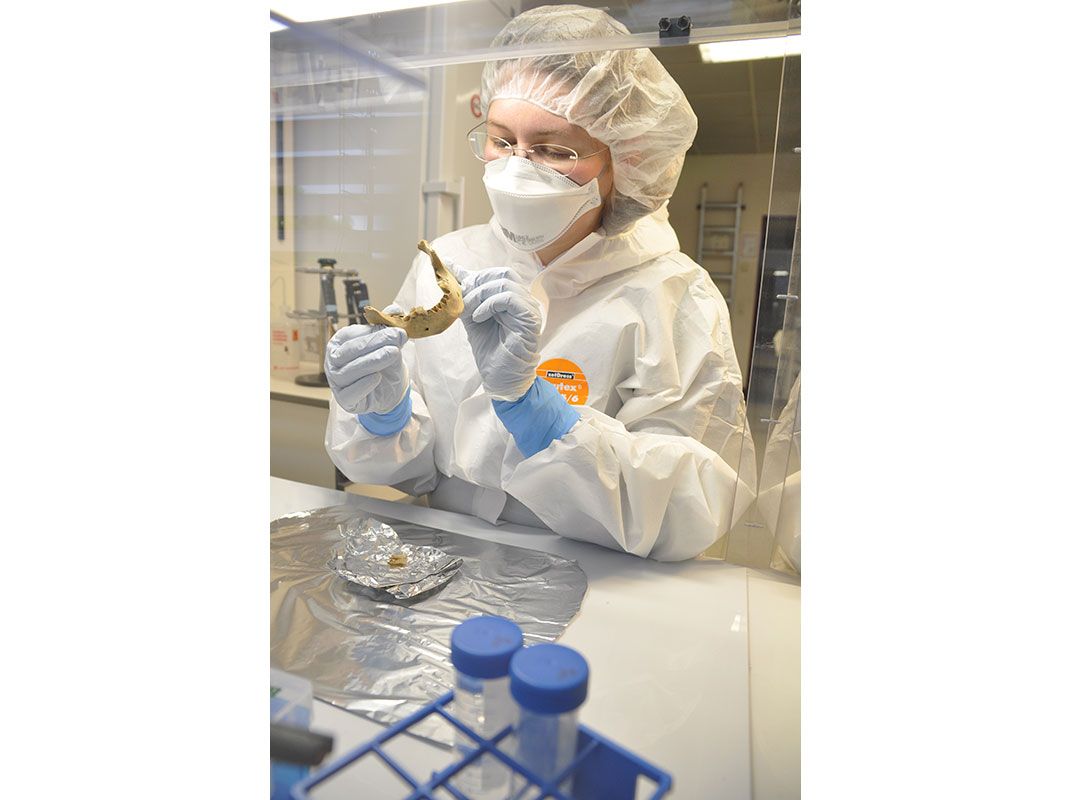Ancient Mummies Finally Give Up Their Genetic Secrets
Armed with new DNA techniques, scientists have extracted genetic sequences from preserved Egyptians
:focal(2242x1361:2243x1362)/https://tf-cmsv2-smithsonianmag-media.s3.amazonaws.com/filer/6a/22/6a2201a8-1f6c-4db1-bde1-77c762a170f4/sarcophagus_tadja_c_aegyptisches_museum_steiss_sandrajpg.jpg)
Historically, the idea of extracting DNA from an Egyptian mummy has been a bit like trying to suck dinosaur DNA out an insect trapped in amber: a tantalizing prospect, but still more myth than science. "This has been around for a long time as a hot topic," says Johannes Krause, a geneticist at Germany's Max Planck Institute for Evolutionary Anthropology. But unlike the dino scenario, it turns out analyzing mummy DNA is actually scientifically possible.
Krause has spent his career teasing information out of very old DNA. His work has led to the discovery of a new subspecies of human, which he helped identify from a bone fragment in a European cave; he also definitively identified the disease behind the infamous Black Death by examining dug-up plague victims. Now he can add another ancient jewel to his list: mummies. His team has managed to extract the first intact DNA from thousands-year-old Egyptian mummies, allowing them to unravel the secrets of their genetic heritage.
The discovery comes out of a relatively new field known as archaeogenetics. It was founded by a Swedish biologist named Svante Pääbo who claimed to have extracted the DNA of 23 ancient Egyptian mummies as a young researcher in the 1980s. However, Pääbo's work fell under heavy criticism from other scientists when it became clear that his DNA samples could be contaminated with modern DNA, Krause says. By the 2000s, some experts had begun to question whether it was even possible to extract usable DNA from mummies that had been weathered for so long by the hot, dry Egyptian climate.
Advances in DNA sequencing technology in the past eight years, particularly "high-throughput" sequencing technology that can sequence millions of DNA base pairs quickly, cheaply and accurately, have reopened the possibility that Egyptian mummies could give up their genetic secrets, Krause says. Last year, he and his colleagues aimed to learn more about the genetic makeup of ancient Egyptian people—and particularly, how their population had been influenced by a particularly turbulent, thousand-year chapter of history.
Starting in the 8th century BCE, waves of migration and conquest from Rome and farther south in Africa shook the region. If they were indeed able to extract mummy DNA, Krause expected to find the effects of this period of invasion—and, presumably, intermixing—written in the genetics.
Drawing on two mummy collections from German universities, the team analyzed more than 150 mummies recovered from an ancient area of middle Egypt called Abusir el-Meleq, a thriving city along the Nile River where many Egyptians were buried starting in 1500 BCE. The mummies ranged in age from 2,000 to 3,000 years old. These were not pharaohs or wealthy Egyptians buried in elaborate stone sarcophagi, Krause says, but rather ordinary, "middle-class" people buried in simple painted wood coffins. "At the time, they mummified almost everything," Krause says, including pets and wild animals.

Using these new techniques, Krause was able to find complete mitochondrial genomes in the tissues of 90 of those mummies, according to a study published yesterday in the journal Nature Communications. While previous studies of ancient mummy DNA tended to focus on sampling from the remaining soft tissues of the bodies (i.e. muscle, skin and organs), Krause says his team found that actually the bones and teeth of the mummies best preserved the people's DNA, because these structures were less exposed to the heat and humidity that can degrade genetic material.
To rule out the contamination that sank previous studies, Krause relied on work of geneticists in the last decade who have learned how to track the damage that occurs to the structure of DNA as it degrades over hundreds or thousands of years. Newer, undamaged DNA that had contaminated a sample would now stand out in an analysis of older, pockmarked DNA. "With these DNA damage patterns, we're really able to authenticate ancient DNA," Krause says.
So how did the genetic makeup of the people living Abusir el-Meleq change in these turbulent centuries?
"Nothing really happened. It was very boring," Krause says with a laugh. Apparently, all that conquering didn’t significantly change the genetics of this Egyptian population—which, in itself, was unexpected. “That was actually a bit of a surprise to us,” Krause says.
Next, Krause wanted to compare what he found in the ancient DNA to the genetics of modern Egyptians, drawing on a genetic survey in 2015 that looked at human migration out of Africa. Predominantly, the modern people sampled appeared to share the most genetic ties with people today living in the Arabic countries of the Middle East. This contrasts with modern Egyptians, Krause says, who now appear to have more genetic origins from sub-Saharan Africa.
This suggests that the invading peoples from Nubia and Rome didn’t significantly intermix with the ancient Egyptians during the centuries before the year 0 AD—but that sometime since, a mass influx of African genes entered the Egyptian population.
American University in Cairo egyptologist Salima Ikram found Krause's work overall to be "well-balanced, well-researched, and well thought-out." However, Ikram, who was not involved in the study, is skeptical about how definitive Krause's comparison to modern Egyptians really is. The genetic survey of modern Egyptians cited by Krause does not specify where the people sampled were from, Ikram says, a data gap that could have big implications on the conclusion.
"Despite mobility, [there] are [still] pockets of ethnic groupings," Ikram says. Samples from southern Egypt or slave-trade centers could therefore show much more sub-Saharan African influence than samples from northern port cities that could have more European influence from the Crusades.
In future studies, Krause hopes to collect more mummy DNA from around Egypt to pinpoint when and why ancient Egyptians began to change genetically—and to find out exactly how their ancestors migrated to the fertile crescent in the first place. "What we're most interested is extending the data back in time," he says.